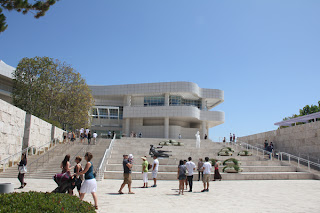Listen to our podcast at http://soundcloud.com/community56/getty-center
Our trip
We’re so honor to talk about our team trip to
Architecture
The main axes of the museum grid that is offset by 22.5 degrees begins with the arrival plaza, carries through the edge of the stairs up to the main entrance, aligns with the columns supporting the rotunda as well as the center point of the rotunda, aligns with benches in the courtyard between the pavilions, includes a narrow walkway between the west and south pavilions, a staircase down to the garden and ends in the garden. The corresponding cross axis starts with the center point of the circle forming the GRI library garden, then passing to the center of the entrance rotunda, and aligning with the south wall of the rotunda building. Although all of the museum is aligned on these alternative axes, portions of the exhibitions pavilion and the east pavilion are aligned on the true north-south axis as a reminder that both grids are present in the campus.
The primary grid structure is a 30-inch square; most wall and floor elements are 30-inch squares or some derivative thereof. The buildings at the Getty Center
Throughout the campus, numerous fountains provide white noise as a background. The initial design has remained intact; however benches and fences have been installed around the plaza fountains to discourage visitors from wading into the pools. Some additional revisions have been made in deference to the Americans with Disabilities Act.
Painting
The permanent collection is displayed throughout the other four pavilions chronologically: the north houses the oldest art while the west houses the newest.
First.Irises by Vincent Van Gogh (1889). The museum purchased the painting in 1990; and it had sold for $53.9 million in 1987. In this painting,a single white iris boldly draws our attention in this vivid and energetic work painted by van Gogh.
second. Sunrise harbor of Le havre Sunrise
Besides painting there’re also a lot of photograph collections. Getty's photograph collection is located on the lower level of the west pavilion. It includes 35,000 individual prints, 1,500 daguerreotypes(də'gɛrə,taɪp) and other cased objects, 30,000 stereographs ('stɛrɪə,græf), and 475 albums containing almost 40,000 mounted prints.
The Getty Museum
Overlook of the Garden
Flowers
Entrance
Statues at the Entrance
Railway Up to the Museum
Mountains
Stream
Overlook of LA
Trees in the Sunset

















